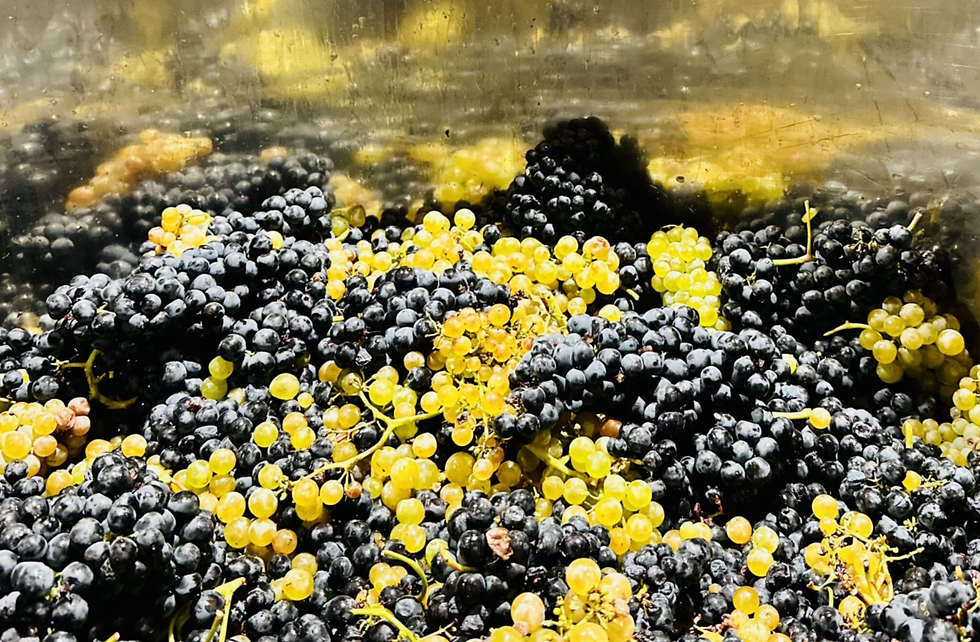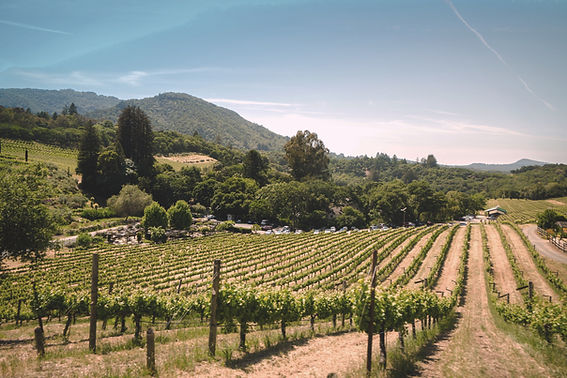Pinea: Extreme Excellence in Ribera del Duero
- Victoria Daskal

- Dec 2, 2024
- 5 min read
Updated: Dec 4, 2024

Over the past 42 years, Ribera del Duero has evolved into one of Spain's premier wine-producing regions. This remarkable transformation is rooted in the vision of early pioneers, the distinctiveness of its terroir, and an unyielding commitment to quality. Once known for bulk wine production, Ribera del Duero now commands global prestige, besides iconic names like Vega Sicilia and Pingus, there are dozens of ultra-premium wines from the region sought out by collectors and connoisseurs.
Its development has had its ups a downs. Parker's influence can still be felt through a common style of big, powerful reds dominated by new oak that might have fit the bill for the typical 100-point wine, but seems old-fashioned by today's standards. Thankfully a second renaissance is upon us, a new wave of Ribera del Duero inspired by authenticity, fruit quality, and the pursuit of excellence.
The Foundations of Ribera del Duero's Success
The story of Ribera del Duero began long before its DO status was granted in 1982. Ancient Romans and later Benedictine monks cultivated vineyards in this rocky landscape of Castilla y León, laying the groundwork for a rich viticultural tradition. Although for much of the 20th century the region was synonymous with bulk wines, everything changed when a group of determined winemakers championed the Ribera del Duero’s distinctive terroir. This is Europe's high-altitude vineyards, carved with diverse soil types, and a harsh continental climate – or as the locals describe it, “nine months of winter and three months of hell.” These conditions foster low yields of exceptional quality grapes, particularly Tinta del País (Tempranillo), which delivers an incredible intensity of complex fruit, structured tannins, and freshness in the wine.
Since its establishment, Ribera del Duero has grown from nine wineries to over 317, encompassing 26,000 hectares of vineyards. Despite this expansion, it remains smaller than Burgundy, and only a quarter of Bordeaux, with a focus on boutique, terroir-driven wines.
Distinctive Grape Varieties

Tempranillo, locally called Tinta del País or Tinto Fino, is the undisputed star of Ribera del Duero. Its early ripening, deep colour, firm tannins, and vibrant acidity make it ideal for producing robust, age-worthy reds. The region’s high altitudes (720 to 1,100 meters above sea level) accentuate its complexity, delivering wines with opulent black and red fruit intensity and refreshing energy.
A lesser-known gem is Albillo Mayor, Ribera’s indigenous white grape, which accounts for just 1% of its vineyards. The wines it produces exhibit lemon, apple, and stone fruit aromas. It's rarely bather in new oak, but can benefit from time in old barre, and lees ageing which develops a lovely mouthfeel.
Historically, Ribera del Duero was known for clareté, a humble wine created by co-fermenting black and white grape varieties, resulting in a deep pink, fruity, textured, slightly high-alcohol wine that complements grilled lamb. Not quite a rosé, in fact it’s somewhere in between a very light red and a rosé with a boost of fragrance and freshness from white grapes.
Despite the continuous evolution in this region, forward thinking producers have managed to combine their premium, modern approach with deep respect for the region's tradition.
Pinea: A Rising Star in the North

Founded by Vicente Pliego and Hugo Del Pozzo in 2017, Pinea epitomizes the innovative spirit of modern Ribera del Duero. Driven by Pliego’s passion for Tempranillo and his Mexican heritage, Pinea is situated in the northern reaches of the DO, where higher elevations and greater temperature fluctuations yield exceptional grapes.
Pliego’s philosophy marries passion and precision, reflecting his admiration for Old World winemaking.
"There are two big schools of wine. The school of blending, where you create the best possible wine by blending different varieties. And on the other hand you have the school of authenticity –the Bourgogne school of terroir. "
Pinea have 35 hectares in northern Ribera del Duero between the villages Olmedillo de Roa and Villatuelda. The land is divided into nine parcels across different altitudes, aspects and soils, allowing for a range of wine styles to be produced from their Tempranillo grapes.

Pinea’s flagship wine Pinea comes from grapes sourced exclusively from their highest altitude vineyard, Cardisanto, with 30+ year old vines in chalky limestone soil. This is the powerhouse wine produced with Burgundy in mind, but from tougher stuff. Equally tough, Pliego explains his mindset on this project:
"Our goal is to make one of the best wines in the world. It was very ambitious, but what is the point if not that? I left my family in Mexico to come here, I really want to place my hands on the soil here. Every aspect of making a world-class wine is demanding."
Meanwhile the 17 is a blend of all nine plots, characterised by its firm yet velvety tannins and a kaleidoscope of flavours showing off Tempranillo's full potential. The Korde range comes in white, rosé, and red styles, embracing the roots of the region through its native white Albillo Mayor, the traditional practice of clareté, and a dynamic expression of Tempranillo.
Tasting Notes from Pinea’s Portfolio
Korde
Korde Blanc (Vintage blend 2022 66%, 2023 34%)
Pale lemon hue. Aromas of baked apple, apricot, and soft vanilla, with hints of toast and dried flowers. Crisp acidity, creamy texture, and a saline, mineral finish. Lees aging adds depth.
Produced every other year with a blend 1/3 & 2/3 of recent vintages due to limited amount of Albillo Mayor vines.
Korde Rosé 2022
Deep pink hue. Vibrant pomegranate and floral notes with balanced acidity. A co-fermentation of Tempranillo and Albillo Mayor, it’s elegant and versatile, especially delicious with spicy foods.
Korde Tinto 2022
Tempranillo grapes for Korde are harvested two weeks earlier to harness their natural freshness. Low maceration, with the inclusion of up to 10% Albillo Mayor.
Bright red cherry and strawberry aromas, with a delightful freshness and finesse. Reminiscent of a fine Fleurie, quite an elegant and light version of Ribera del Duero at only 13.5%. Try this slightly chilled!
17 by Pinea
100% Tempranillo blended across all nine plots from different soils, altitudes, aspects and vine ages. Hand-harvested, natural fermentation in stainless steel tanks. Aging in a combination of new and used French oak barrels, and concrete eggs for two winters.
2021 - Deep, complex nose of black and blue fruit, intertwined with warming cedar and spice notes. Earthy, gutsy and broad shouldered with velvety smooth tannins.
2022 - Dark purple hue. Vivid and ripe black cherries and prunes. Quite chunky and rich tannic structure, but still energetic and fresh. Balanced and long with a savoury finish.
2023 - Barrel sample. Inky purple ruby hue. Bright and fresh fruit plunging into star anise, cedar and plums. Energetic and smooth, already quite deliciously drinkable.
Pinea
Single-vineyard Tempranillo, from the Cardisanto plot at 931-942meters above sea level, on loamy clay soils. Hand- harvested, natural yeast fermentation, with 20-30% whole bunch in 500L French oak barrels, and remains there for MLF and 3 winters of aging.
2019 - Deep garnet hue. Attractive sweet black plum and prunes laced with smoke and dried Mediterranean herbs. Pure ripe fruit on the palate with big, but completely refined tannins. Beautifully long finish, touch of charcuterie and leather at the end.
2021 - From a cooler vintage. Rich texture with heaps of black and blue forest fruit and some violet undertones. Structured with fine-grained tannins, and elegant balanced acidity with a surprising saltiness.
2022 - Vibrant nose of blackberries, cherries, crushed thyme and black olive tapenade. Very classy wine with smooth yet powerful tannins. A voluptuous mouthfeel but with restraint.
2023 - Barrel sample. Astonishingly drinkable at this young stage. Nose of prunes, graphite and violets. An exuberant freshness and ripe tannins on the palate. Very promising.

Pinea is a testament to the potential of New Wave Ribera del Duero, crafting wines that honour tradition while looking boldly to the future. Learn more about them at pinea.wine Produced in partnership with Pinea.
















コメント